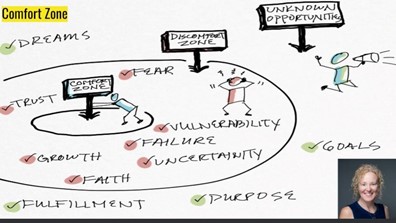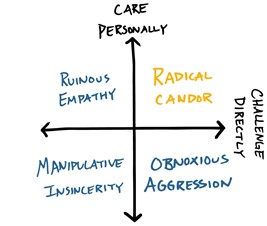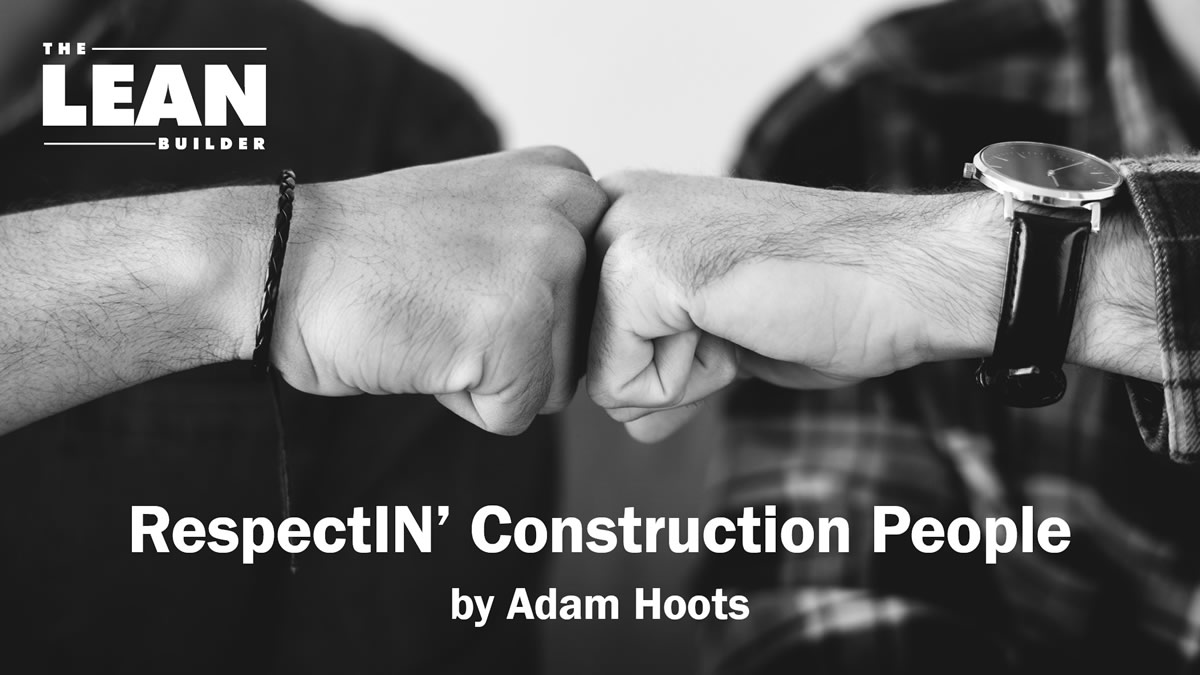Learn The Last Planner System’s Lean Respect for People by following three basic concepts outlined by Lean Expert Adam Hoots of Construction ACHE Solutions.
RespectIN’ Construction People
 I was 17 years old and had just finished repairing a sanitary sewer pipe at a local high school in Orlando, FL in the middle of summer. I was a plumber’s helper and at the bottom of the proverbial totem pole. While repairing the damaged sanitary pipe, I was exposed to an environment that no animal should ever be exposed to. I will never forget riding home in my black 1996 Chevrolet Cavalier Z24 on a 98-degree day, with no air conditioning and sweat pouring down my forehead. The lack of respect for myself was real and hit me harder than the stench of that ditch. That was the life that I would live for the remainder of the summer.
I was 17 years old and had just finished repairing a sanitary sewer pipe at a local high school in Orlando, FL in the middle of summer. I was a plumber’s helper and at the bottom of the proverbial totem pole. While repairing the damaged sanitary pipe, I was exposed to an environment that no animal should ever be exposed to. I will never forget riding home in my black 1996 Chevrolet Cavalier Z24 on a 98-degree day, with no air conditioning and sweat pouring down my forehead. The lack of respect for myself was real and hit me harder than the stench of that ditch. That was the life that I would live for the remainder of the summer.
Through the Skilled Trades Alliance, I have been encouraging young people to enter the skilled trades for the past 5+ years…and I have recently started to feel guilty about that. As I reflected with Davis and Walker on The Laying Foundations Podcast, I’ve realized the huge amount of disrespect that still pervades the construction industry. There have been some strides to improve but, like many others, they seem to fade away as quickly as they arrived.
Respect for People
The industry has adopted the saying “respect for people” and it seems like we are all just supposed to know how that works. But I think that, like the integration of The Last Planner® System was outlined in Joe and Keyan’s book, The Lean Builder, there are individual steps that one can take to build respect for people. This blog will describe some basic steps to introduce respect for people with the following concepts:
- Pause, Reflect, and Share
- Get people outside of their comfort zones
- Give AND receive “Radical Candor Feedback”
Pause, Reflect and Share
At regular intervals, teams must intentionally stop producing to reflect on progress. These periods of reflection are where learning happens. Learning is an independent process and cannot be forced. One can encourage learning, but the timing of a “light bulb moment” is specific to the learner. When teams learn together, deeper connections develop—connections both to work and to people. Embrace those awkward moments of silence and understand that silence is the sound of thought.
I encourage teams to spend a minimum of 5% of their week learning from experience and harvesting innovation to improve actions moving forward. Lean practitioners often refer to the PDCA (Plan, Do, Check, Act) or PDSA (Plan, Do, Study, Adjust) cycle, depending on which Lean terminology they subscribe to. One of the most important things to remember as builders is that what got us here, will not get us there!
Get outside of your comfort zone
The best leaders can get outside of their comfort zones before others on a routine basis. A great Lean leader and friend of mine, Jen Lacy, created this diagram to help people understand how to achieve this.
 This map also helps people to understand that through their discomfort zones lies an unknown opportunity zone that is filled with learnings and growth! This could be as simple as allowing someone else to have the last word on your next phone conversation or allowing your craft foreman to take more of a leadership role in the daily huddle meetings.
This map also helps people to understand that through their discomfort zones lies an unknown opportunity zone that is filled with learnings and growth! This could be as simple as allowing someone else to have the last word on your next phone conversation or allowing your craft foreman to take more of a leadership role in the daily huddle meetings.
Spreading responsibility and/or learning new things about people will help to increase a desire to contribute as a team member. Encourage your team to take “5 minutes to shake 5 hands” while meeting new people on the project site. Empower the workers by bringing them outside of their comfort zones, too. This is very much like a roller coaster ride; the first time is terrifying, but after you’ve done it once, you’ll be yearning for more!
Give and Receive “Radical Candor Feedback”
Feedback is difficult to both give and receive. The only valid response to someone providing you feedback is, “Thank You!” It’s important to note that feedback is only one person’s opinion of the situation and/or suggestions for improvement. This feedback could be right, wrong, or irrelevant. It is only relevant after you have started to recognize trends or patterns in the information that is being presented to you. Then you should consider taking action to fix the things that other people have repeatedly shed light on.
Perhaps you have heard the concept of providing a feedback sandwich that helps soften the sting of critical feedback by presenting a positive version before and after the critical feedback. I’m here to tell you this approach does not work. This does soften the impact of critical feedback but doesn’t allow focus on the improvement. When you need to provide critical feedback, this must come from a place of radical candor. Radical Candor, by Kim Scott, offers the concept of caring personally and challenging directly. These two must be combined, or the person receiving the feedback will believe you to be obnoxiously aggressive, ruinously empathetic (just trying to be nice), and/or manipulatively insincere.
 On project sites where I coach, I create a circle of trust to better understand and discuss where the trust of the project is centered. I draw a circle on the wall and put a dot in the center which represents the most trust that I have for anyone. Then I list out trade partners and get a feel for the room’s thoughts and energy as I ask open ended questions. The team assigns a place inside or outside of the circle depending on how much the project team trusts each trade. This draws some great conversation centered around feedback. As project teams, we often vent about these things that we don’t like but how often does that information get back to the people that can do something about it?
On project sites where I coach, I create a circle of trust to better understand and discuss where the trust of the project is centered. I draw a circle on the wall and put a dot in the center which represents the most trust that I have for anyone. Then I list out trade partners and get a feel for the room’s thoughts and energy as I ask open ended questions. The team assigns a place inside or outside of the circle depending on how much the project team trusts each trade. This draws some great conversation centered around feedback. As project teams, we often vent about these things that we don’t like but how often does that information get back to the people that can do something about it?
Value Skilled Trade Workers
As this realization has come to fruition, the Skilled Trades Alliance has modified its two-prong approach to change the cultural landscape of the construction industry and drive respect back into the trades. After all, doctors cannot heal without skilled trade workers. Judges cannot maintain the law without skilled trade workers. Teachers cannot enlighten without skilled trade workers. Project supervisors cannot manage or oversee work without skilled trade workers. Society functions because of skilled trade workers.
Skilled trade workers are human beings. They have purpose, they have value. I challenge you to learn something on your jobsite today—it does not have to be technical in nature; it could be something as simple as a trade person’s least favorite food. I’m asking you to show “humble inquiry” to the people on your project site!
Another friend of mine—a podcasting, salsa dancing, 2nd generation plumber named Jesse Hernandez, is the host of The Learnings and Missteps Podcast . He says there are three easy questions to toss out there to get the conversation flowing:
- Where are you from?
- How long have you been in your trade?
- How is this project in comparison to other projects you’ve been on?
Lean Respect for People
Before you know it, these three questions will have you outside of your comfort zone! It will also help the person you are engaging with to pause and reflect, and maybe even get them outside of their comfort zone, where you both are learning together!
As leaders in the industry, we must empower our skilled trade workers to innovate and make decisions that best affect the quality and safety outcomes.
Please do not allow another 17-year-old child to drive home without respecting themselves as a productive member of society, the way I did that one hot summer so many years ago. These kinds of feelings have lasting impacts on people and can lead to mental health issues, family problems, and/or a stereotype of the construction industry that drives people away for the next 50 years!
Ultimately, we are talking about project culture here. We will bring respect back to the trades when leaders on projects are able to create environments where teams can get outside their comfort zones, pause, reflect, and share radical candor feedback, and learn. This is The Lean Builder’s approach to establishing a positive culture on a project site.
Sawubona – “I See You”
 I challenge the industry to terminate the phrase “respect for people” and replace it with “Sawubona”. The Zulu Tribe say it best when they recognize that someone exists as a human being and has value to offer. The next time you greet someone on a project site say, “Sawubona” before you launch into Jesse Hernandez’s three open-ended questions.
I challenge the industry to terminate the phrase “respect for people” and replace it with “Sawubona”. The Zulu Tribe say it best when they recognize that someone exists as a human being and has value to offer. The next time you greet someone on a project site say, “Sawubona” before you launch into Jesse Hernandez’s three open-ended questions.









